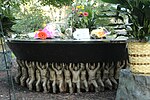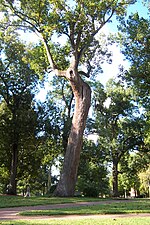Beta Theta Pi Fraternity House (Chapel Hill, North Carolina)
Beta Theta Pi housesBuildings and structures in Chapel Hill-Carrboro, North CarolinaColonial Revival architecture in North CarolinaNational Register of Historic Places in Orange County, North CarolinaResearch Triangle region, North Carolina Registered Historic Place stubs ... and 2 more
Residential buildings completed in 1929Residential buildings on the National Register of Historic Places in North Carolina

Beta Theta Pi Fraternity House, also known as the Eta chapter of Beta Theta Pi, is a historic fraternity house located at Chapel Hill, Orange County, North Carolina. It was built in 1929, and consists of a 2 1/2-story, five bay by three bay, brick main block flanked by lower 2 1/2-story, brick wings with gambrel roofs. The house is in the Southern Colonial Revival style and features a full-width, flat-roof portico with Doric order columns. The Eta chapter was first active at the University of North Carolina at Chapel Hill from 1852 to 1859, then reestablished in 1884.The fraternity house was listed on the National Register of Historic Places in 2005.
Excerpt from the Wikipedia article Beta Theta Pi Fraternity House (Chapel Hill, North Carolina) (License: CC BY-SA 3.0, Authors, Images).Beta Theta Pi Fraternity House (Chapel Hill, North Carolina)
East Franklin Street,
Geographical coordinates (GPS) Address Nearby Places Show on map
Geographical coordinates (GPS)
| Latitude | Longitude |
|---|---|
| N 35.913611111111 ° | E -79.055555555556 ° |
Address
Sup Dogs
East Franklin Street 107
27514 , Bolin
North Carolina, United States
Open on Google Maps











